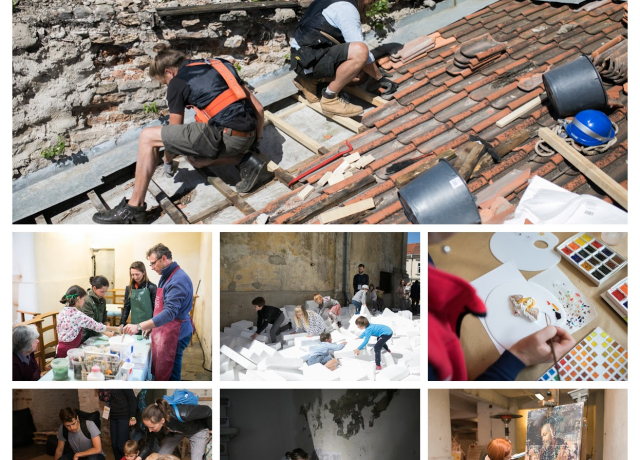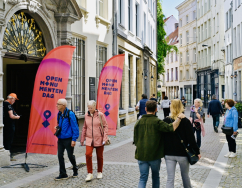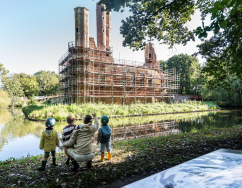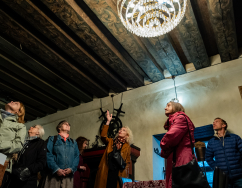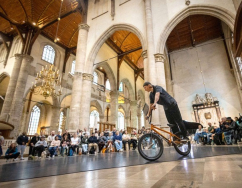European Heritage Days Article:
The Role of Public Awareness in Safeguarding Architectural Heritage
European Heritage Days Article:
The Role of Public Awareness in Safeguarding Architectural Heritage
Photo: Heritas – a Space to Gather Cultural Heritage Professionals and Lovers, EHD Story, Lithuania (credit, Heritas)
This article looks at the importance of connecting with local communities in the preservation and appreciation of architectural heritage; highlighting case studies and organisations which have successfully engaged with the public and ideas for how these approaches can translate into European Heritage Days events.
Public awareness raising through European Heritage Days
With up to 20 million visitors each year, European Heritage Days is the biggest participatory cultural event in Europe. And with two of its key aims being stimulating appreciation of European cultures and informing the public about the need to protect cultural heritage, it puts public awareness raising at the heart of its activities. The events are run independently by each participating country, often opening historic buildings to the public for free. The impact of European Heritage Days on public awareness and support of historic places can be seen in 2024 research conducted by Heritage Open Days in England where over a fifth of visitors had not otherwise been to a heritage site in the last 12 months, showing that the festival is an opportunity to engage with new audiences. The events also inspired people to discover more historic places with 58% of visitors intending to visit heritage sites more often afterwards, as well as resulting in financial support for participating organisations with an estimated £3.7 million additional spend at event sites and 67% of visitors making a donation when they saw an opportunity to do so.
Alongside the events themselves, other European Heritage Days initiatives aim to engage with specific audiences such as the Young European Heritage Makers competition. This asks children aged 6-17 to explore aspects of their heritage, sharing their voices with the wider public on our website, while the European Heritage Days Stories initiative also publishes information about the heritage work undertaken by EHD communities across Europe.
Demonstrating collective strength
While many countries have planning systems in place to protect significant heritage buildings, development pressures and limited budgets can still make it challenging to protect historic places. Positive public sentiment about historic buildings can help in protecting these places by demonstrating how much people value their architectural heritage. One organisation which highlights how the strength of public support can help save endangered heritage sites is the National Trust for Italy (Fondo per l’Ambiente Italiano). The foundation uses a public voting system for its Places of the Heart campaign to bring attention to buildings which are at risk of being forgotten and which can then apply for funding. Over the past 20 years, 11 million votes have resulted in 163 protection and enhancement projects including clearing the invasive foliage which was damaging the walls of the 18th century Citadel of Alessandria fortifications, and restoration work to clean and preserve the 17th century frescos at the Palazzo Guarnieri.
A voting-style activity could be an interactive way to get visitors involved in European Heritage Days events, with one idea from this year’s brochure being a ‘the good, the bad and the ugly’ online vote for the community to have their say on the most and least liked buildings in a town or city. The results could then be used in a public discussion panel to gather improvement ideas. Community-led walks to allow local people to explain the architecture they like is another way to include the voices of members of the public.
Actively participating in taking care of buildings
A proactive outcome of public awareness on safeguarding historic buildings can be to get people actively involved in the conservation work needed to restore and maintain the places they love. This can be seen in a restoration project from the European Heritage Days Stories collection where a group of archaeologists formed an association to create the first archaeological park in North Macedonia on a site featuring a 2,500 year-old Royal tomb. Gaining the engagement of nearby residents was crucial for the project’s success, and as public awareness grew the project started to attract support from people from surrounding villages who volunteered for work from clearing rubbish from the area to helping liaise with local government. Now with informative signage and new landscaping, the site is run as a tourist attraction in partnership with the local community. Showcasing successful conservation stories like this as part of European Heritage Days events can be useful in demonstrating what can be achieved, potentially inspiring other places and community groups to start their own project.
Another example of community-led restoration work is the ‘Adopt a Monument’ project in Finland which encourages residents to ‘adopt’ a historic place which is in need of maintenance in their local area. Overseen by conservation professionals, members of the public help to restore smaller unprotected buildings and take on the role of managers to monitor their condition, research the history of the site and bring them back into use as the venue for events. Many countries across Europe have a similar scheme, such as in Ireland where places from castles and churches to mining buildings and sports venues have been adopted, whilst versions of the concept specifically designed for school children take place in Spain as well as other countries. Working with local authorities, building owners and historical societies, European Heritage Days events could use this model to arrange special volunteering days to get involved in caring for historic places, while tours around buildings which rely on volunteers could be used as an opportunity to connect with people who are interested in providing help on an ongoing basis.
Learning from heritage professionals
Heritage charities, non-profits and other organisations often have public outreach goals. As explained in a European Heritage Days Story, one example of this is Heritas in Lithuania. This initiative is focused on encouraging public participation and leadership in cultural heritage conservation; providing events such as seminars and workshops for people to learn from heritage professionals. In 2018, this included work to replace tiles and conserve the wall paintings at the 18th century Blessed Virgin Mary of Consolation church in Vilnius, with special activities also designed for children to get involved.
Another example of an organisation promoting cultural heritage conservation is the Sites & Cités Remarquables network, which unites municipalities to promote the conservation of historic towns and cities across France. The approach here provides a platform for a network of over 310 member places to find resources and exchange skills, experiences and questions about urban planning and heritage. For example, a recent workshop focussed on raising awareness as part of a strategy for the renovation of residential buildings in old town centres, while training in digital marketing and communication was designed to help them promote their heritage work more widely. European Heritage Days is an opportunity for these kinds of organisations to connect with the public, while talks, tours and demonstrations are great types of events for bringing together experts with members of the public to spark interest and education.
Amplifying voices and communication
Utilising social media is not only a great way to advertise European Heritage Days events but could also be used as a platform for online initiatives which encourage visitors to share their passion for architectural heritage with their communities. An example of how public participation can be used to widen reach and give individuals a voice about places they care for can be found in the ‘This Place Matters’ European Heritage Days Story. For this campaign, participants in the Republic of Moldova took a photo of themselves holding the campaign poster in front of historic or cultural sites which mattered to them and then shared them on social media using the hashtag #LoculAcestaConteaza (#ThisPlaceMatters). Campaign objectives included highlighting the importance of rural places, exploring the value of sustainable adaptation of historic structures, and emphasising the fact that neglected and destroyed places risk being lost forever, with residents in over 20 towns and villages creating visibility of these issues online. When posting on social media about this year’s events, don’t forget to use the hashtags #EuropeanHeritageDays and #ArchitecturalHeritage to connect with us!
For more thoughts about the importance of community engagement in preserving Architectural Heritage, take a look at the section ‘the power of public awareness in safeguarding Europe’s architectural legacy’ in this year’s brochure for event organisers..
